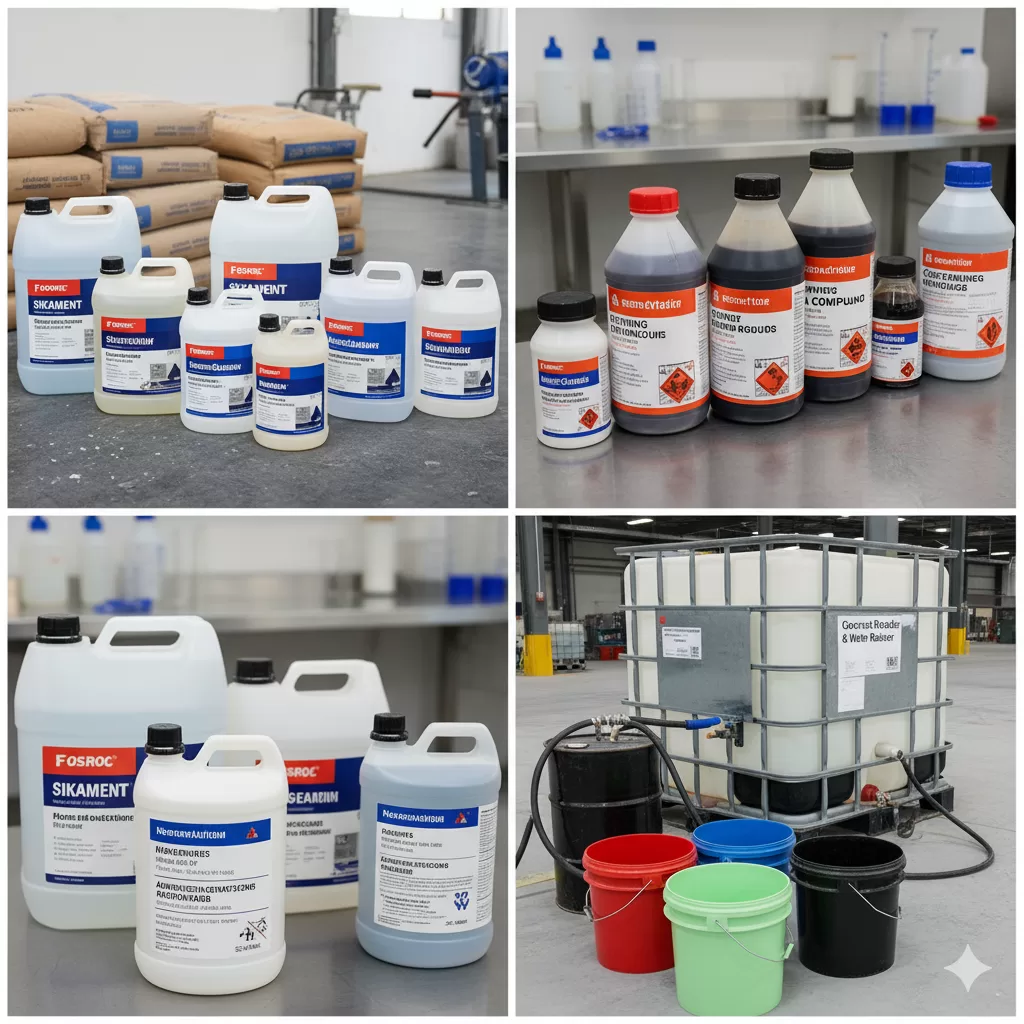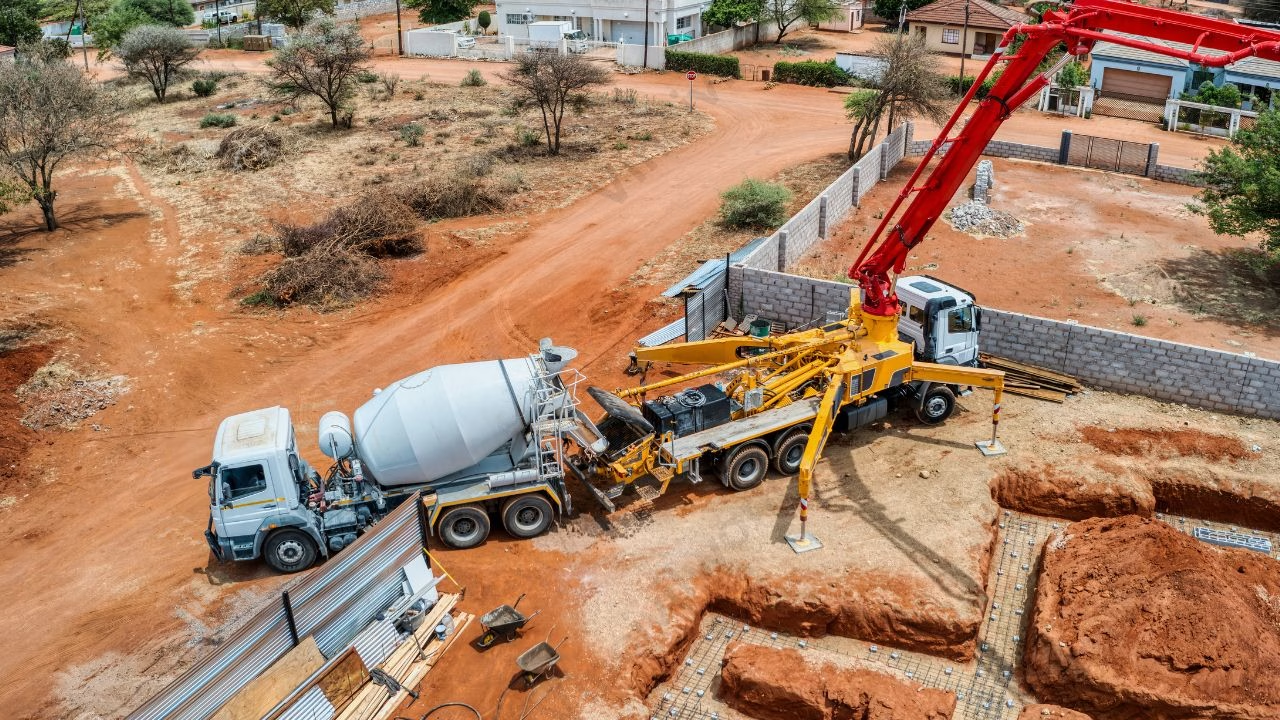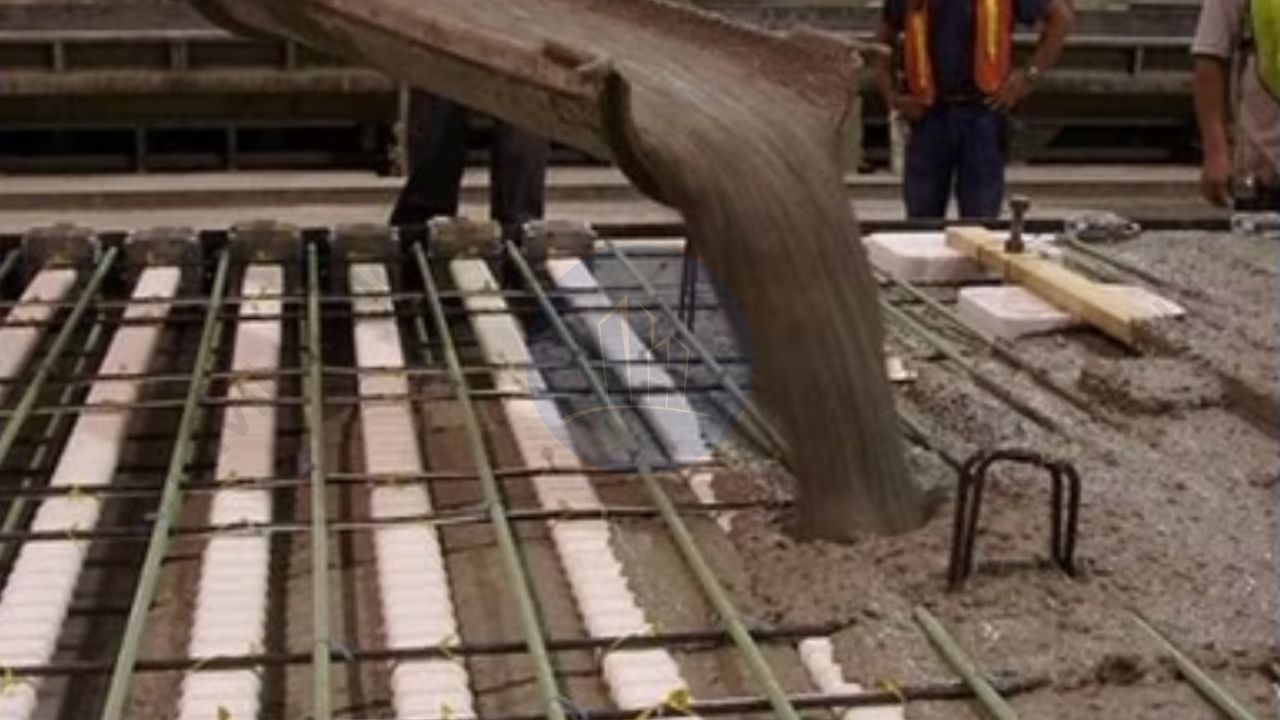The types and uses of admixtures in concrete depend on the structure’s purpose, design strength, placement conditions, and performance requirements. Concrete, the most used construction material, combines cement, sand, water, and aggregates. An admixture is added to this mix to improve or alter specific properties, making it more adaptable to environmental and structural demands. Concrete used in modern infrastructure faces challenges like extreme temperatures, moisture, and chemical exposure. Hence, concrete admixtures are essential for creating high-performance, durable, and long-lasting concrete. Generally, admixtures are divided into chemical admixtures and mineral admixtures. This article explains their types, functions, and applications in detail.
Table of contents
Definition of Admixture and its types
An admixture is a natural or manufactured chemical or additive blended into concrete during mixing. Their primary role is to alter the properties of either the fresh (plastic) or hardened concrete, making it more desirable for a certain condition. An admixture is a material added to concrete, before or during mixing, to modify its properties. Admixtures enhance workability, durability, strength, and setting time, making concrete suitable for specific construction needs. By using the right types of admixture in concrete, builders can achieve higher performance and reduce construction costs.
🔗 Related Read: Slump Test for Workability of Concrete
Uses of different types of admixtures in concrete
Each admixture type performs distinct functions that improve concrete performance. The benefits of using admixtures are numerous, improving both the concrete’s performance and the efficiency of construction:
- Improved Workability: Increases the ease of handling, placing, and compacting the concrete.
- Enhanced Durability & Strength: Increases resistance to environmental factors and boosts long-term strength.
- Water Reduction: Allows for a lower water-cement ratio while maintaining workability, which significantly increases strength.
- Setting Time Control: Accelerates or retards the concrete’s setting time to suit different temperatures or construction schedules.
- Reduced Defects: Limits problems like shrinkage cracking, bleeding, and segregation of concrete.
- Corrosion Protection: Reduces the corrosion rate of reinforcement steel.
- Economic Savings: Can reduce construction costs by optimizing material use or speeding up construction.
- Decreases Heat of Hydration.
Types of Admixture used in concrete
Admixtures are primarily classified into two broad categories: Mineral Admixtures and Chemical Admixtures.
- Mineral admixtures
- Chemical admixtures
Types of Mineral Admixture
Mineral admixtures are siliceous and insoluble materials other than cement and aggregate that are added to concrete in concentrations ranging from 20 to 70% by mass of cement. These are fine materials that have an impact on concrete via hydraulic and pozzolanic activity. They affect the concrete through hydraulic (reacting with water) or pozzolanic (reacting with calcium hydroxide) activity. Natural materials, processed natural materials, and artificial materials are all examples of mineral admixtures. The following are some types of mineral admixture commonly used in concrete.
Common types of mineral admixture include:
- Fly Ash (Flash): A byproduct of coal-fired power plants. It significantly improves long-term strength, reduces permeability, and helps decrease the heat of hydration.
- Silica Fume: An extremely fine byproduct of silicon and ferrosilicon alloy production. It creates ultra-high-strength concrete with exceptional density and low permeability.
- Ground Granulated Blast-Furnace Slag (GGBFS): A byproduct of steel manufacturing. It improves workability and provides strong sulfate resistance, excellent for marine environments.
- Metakaolin: A material produced by calcining purified kaolinite clay. It offers similar performance to silica fume but with a lighter color.
- Rice Husk Ash: A highly pozzolanic agricultural waste product.
These admixtures enhance resistance to sulphate attack, reduce permeability, and improve workability in both hot and cold climates.
Types of Chemical Admixture
Chemical admixtures for concrete are compounds that alter its physical and chemical behavior to achieve specific results such as delayed setting, rapid hardening, or water reduction. Chemical admixtures are organic or inorganic chemicals added to concrete in very small amounts (usually less than 5% by mass of cement). They are designed to modify the fresh or hardened properties of concrete immediately.

The most common types of chemical admixture include:
- Plasticizers (Water Reducers): These decrease the water requirement for a given slump (workability) by about 5% to 15%.
- Superplasticizers (High-Range Water Reducers): Highly effective chemicals that can reduce the water content by over 12%. They are essential for producing high-strength concrete or “flowing concrete” that can be placed easily in densely reinforced sections.
- Accelerators (Accelerating Admixtures): Decrease the initial setting time of concrete. Used in cold weather or when rapid formwork removal is necessary. The most common example is calcium chloride.
- Set Retarders (Retarding Admixtures): Increase the setting time of concrete. Ideal for hot weather or for complex pours that require a long transportation or placing time.
Types of concrete admixture based on applications
Admixture is classified into various types based on various applications
- Water-reducing admixture
- Retarding admixture
- Accelerating admixture
- Air entraining admixture
- Pozzolanic admixture
- Damp-proofing admixture
- Gas forming admixture
- Air detraining admixture
- Anti-washout admixture
- Corrosion inhibiting admixture
- Bonding admixture
Water-reducing admixtures
Plasticizers are another name for water-reducing admixtures. Basically, by lowering the water-cement ratio, they assist in reducing the water content of the concrete mix by 5 to 20%, resulting in high-strength concrete. Workability is increased by water-reducing admixtures because they can even maintain a high slump without adding more water. Examples include polycarboxylates, multicarbovyl ethers, and acrylic polymers. etc.
Retarding admixtures/Retarders
Retarding admixtures or retarders decreases the setting rate of concrete. They are suitable in hot weather conditions where the high temperature drastically increases the setting rate of concrete. However, the fast setting rate of concrete affects its strength and durability. Generally, retarding admixtures are widely used to overcome this problem. Some examples of retarders are Starch, cellulose products, common sugar, acid salts, etc.
Accelerating admixture/Accelerators
Accelerating admixture decreases the initial hardening time of concrete. As a result the rate of hydration of cement increases. There are two types of accelerating admixtures.
- Set accelerating admixture
- Hardening accelerators
Accelerating admixture improves the concrete strength by increasing the rate of hydration. This type of admixture is suitable for early formwork removal, emergency repairs, buildings in low-temperature regions, etc. Some examples of accelerators are triethanolamine, calcium formate, active silica, calcium chloride, finely divided silica gel, etc.
Air entraining admixtures
During concrete mixing, these admixtures introduce and stabilize microscopic air voids while forming air bubbles in the mix.
Similarly, these admixtures impart air entrainment that results in:
- Increased resistance to deterioration from cyclic freezing and thawing
- Improved workability and cohesiveness of concrete placement
- Reduced segregation and bleeding
🔗 Learn More:
Pozzolanic admixtures
These admixtures are suitable for hydraulic structures such as dams, reservoirs, etc. Pozzolana is a cementitious material that helps in preparing high-dense concrete mixes. Accordingly, It increases the strength, and reduces the cost of concrete and thermal shrinkage. Some examples of pozzolanic admixtures are fly ash, silica fume, rice husk ash, metakaolin, etc.
Damp proofing admixtures
Dampproofing admixtures make the concrete impervious and durable. It also helps in attaining the early stage of concrete hardening. Some examples of dam-proofing admixtures are hot bitumen, mastic asphalt, bituminous felt, etc.
Gas forming admixtures
During the hydration process of cement, we get hydroxide. The gas-forming admixture reacts with the hydroxides and forms hydrogen gas bubbles. This bubble helps in avoiding settlement and bleeding of concrete. Some examples of gas-forming admixtures are Aluminum powder, activated carbon, hydrogen peroxide, etc.
Air detraining admixture
During the mixing of concrete, the air gets entrapped in the concrete. Furthermore, this air reduces the strength of the concrete. So to avoid this air content we use air-detraining admixtures. Some examples of this type of admixture are tributyl phosphate, silicones, water-insoluble alcohols, etc.
Anti-washout admixture
Generally, the main application of anti-wash-out admixtures is in underwater construction. Some examples are natural or synthetic rubbers, thickeners based on cellulose, etc. Similarly, It makes the concrete more cohesive and avoids washing out of concrete mixes underwater.
Corrosion inhibiting admixture
Corrosion of reinforcement is one of the common problems in construction. So to decrease the corrosion this type of admixture is used. Basically, corrosion-inhibiting admixtures help in decreasing the corrosion rate and delaying the corrosion. Some examples of corrosion-inhibiting admixtures are sodium benzoate, sodium nitrate, sodium nitrite, etc.
Bonding admixture
This type of admixture helps to the bond between the new and old concrete surface. Basically, It is commonly used in floor overlays, screed over roofing, repair work, etc. Some examples of bonding admixtures are natural rubber, synthetic rubbers, and polymers such as polyvinyl chloride, polyvinyl acetate, etc.
Key Takeaways
Here are the essential points regarding the types of admixture used in concrete:
- Classification: Admixtures primarily divide into Mineral Admixtures and Chemical Admixtures.
- Mineral Admixtures: These are pozzolanic materials (e.g., Fly Ash, Silica Fume, Slag) that improve long-term strength, reduce permeability, and lower the heat of hydration.
- Chemical Admixtures: These organic/inorganic chemicals modify properties of fresh concrete.
- Plasticizers/Superplasticizers: Water-reducing admixtures that allow a lower water-cement ratio, resulting in higher strength concrete.
- Accelerators/Retarders: Used to precisely control the setting time—accelerators for cold weather or quick turnaround, retarders for hot weather or long hauls.
- Air-Entraining Agents: Crucial for improving freeze-thaw resistance and enhancing the durability of concrete in cold climates.
- Specialized Types: Other types include anti-washout, corrosion-inhibiting, and bonding agents, each serving a unique functional requirement.
Conclusion
Admixtures are indispensable ingredients in modern construction, acting as performance enhancers to tailor concrete for specific demands. They broadly categorize admixtures into chemical admixtures and mineral admixtures (Supplementary Cementitious Materials). Chemical types, like plasticizers and accelerators, modify fresh properties such as workability and setting time immediately, requiring small doses. Mineral types, such as fly ash and silica fume, enhance long-term durability, strength, and impermeably using larger volumes. The proper selection of admixture, based on project requirements like climate, structural strength, and exposure conditions, is paramount. Utilizing these specialized materials is essential for producing the high-performance, cost-effective, and long-lasting concrete required for today’s sophisticated infrastructure.





One thought on “Types of Admixture in Concrete – Functions, Types and Uses Explained”
Comments are closed.